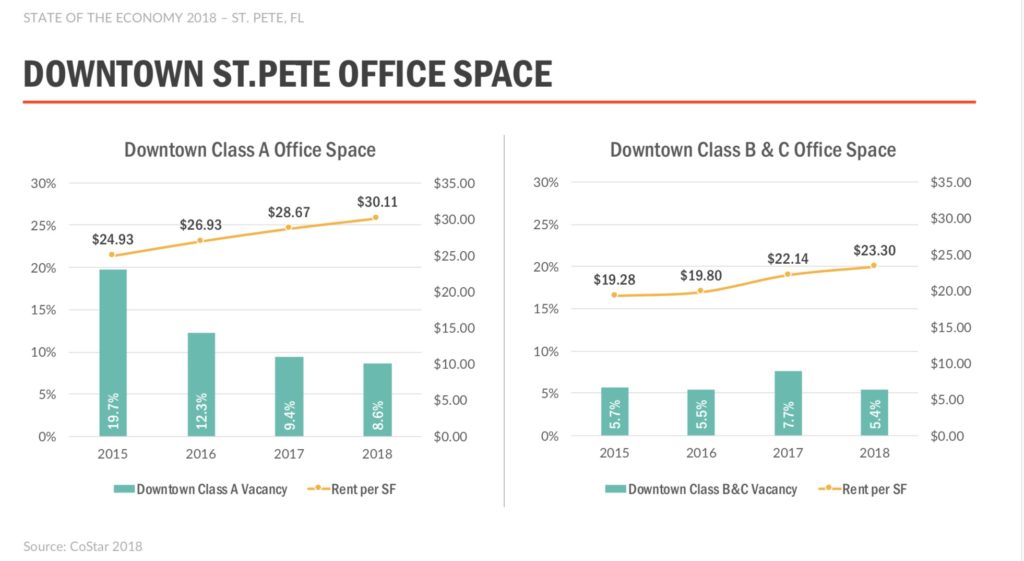Know
St. Pete office construction nears ‘inflection point’

With vacancy rates in downtown St. Petersburg falling and rents climbing, the city could soon see new office space being built.
“We’re beginning to see an inflection point where new construction is going to begin again,” said Larry Feldman, chairman and CEO of Feldman Equities Inc., during a panel discussion at the city’s State of the Economy presentation Wednesday.
Downtown St. Pete has all the ingredients for a successful office market, said Scott Stahley, executive vice president of Lincoln Property Co., which recently bought the Tampa Bay Times building. But economic factors such as land and construction costs still make it difficult for developers to pull the trigger on an office development, said Wendy Giffin, director at Cushman & Wakefield, and Darryl LeClair, CEO, president and chairman of Echelon LLC.
United Insurance Holdings Corp. (Nasdaq: UIHC) plans to build a new headquarters at 800 1st Ave. S., which would be the first new office construction since the Duke Energy headquarters on 1st Avenue North opened in 2007.
The 86-acre Tropicana Field site and the old St. Petersburg Police headquarters, both slated for redevelopment, are prime opportunities, said Alan DeLisle, the city’s development administrator. So are two acres of vacant land at 4th Street and Central Avenue, currently owned by New York developer Red Apple Group. “I think you’ll see some movement on that this year,” DeLisle said.

A two-acre vacant parcel at 4th Street and Central Avenue, just a block from the Tampa Bay Times building
The Red Apple site is just north of the Tampa Bay Times building, acquired last month by Lincoln Property for $39.4 million.
Lincoln had a long legacy in Tampa, dating back to the 1980s when the company helped develop Harbour Island, but the company “took a recess” from that market in the last decade, Stahley said.
“Now we’re picking and choosing our spots to come back to the Tampa Bay area, and we didn’t go to Tampa. That’s because St. Pete has more ingredients than Tampa does, from our standpoint of what makes a location successful for office,” Stahley said. “You can basically hang a ‘full’ or ‘no room at the inn’ sign in downtown St. Pete, which is part of the reason we went after the Times building. We saw an opportunity to take the development risk off the table and buy into a building that had occupancy and had vacancy with the Times reducing its space.”
L3 Technologies has just announced it is moving the corporate headquarters for its commercial aviation solutions unit and 250 jobs, into the building, but that had less to do with the structure and more to do with other factors such as housing and walkability that appeal to a millennial workforce, Stahley said.
Giffin has just leased five full floors in 200 Central — the former Bank of America building now owned by Third Lake Capital — and the last new office building constructed downtown.

Feldman Equities has a 1.9 million-square-foot portfolio that includes First Central, City Center and Morgan Stanley Tower in downtown St. Pete and that portfolio is 95 percent leased, Feldman said. But that’s not unique, he said.
“We’re seeing some of the lowest vacancy rates we’ve seen in 20 years in the Tampa-St. Pete metro, and we’re now 250,000 jobs higher than at the 2006 peak. Office space and jobs are linked at the hip. With that job increase you would think we would be even lower on vacancy rates,” he said. “What has counterbalanced is more and more people are going into less and less space, as companies try to squeeze the bottom line and extract as much profitability as they can … But that’s coming to an end.”
Eliminating impact fees for development projects would provide an incentive to build, Feldman said. He suggested the city consider a bonus for developers who build taller structures, and said he was pleasantly surprised to hear Mayor Rick Kriseman open the State of the Economy presentation by saying the city needs density and height in order to keep growing.
“My progressive friends need to understand that height done properly is a good thing. A skyline can be our friend,” Kriseman said.
But the economics that make a new office project feasible for a developer aren’t quite there yet, said LeClair, because of the cost of buying land and paying for construction.
New construction in Water Street Tampa, Strategic Property Partners’ $3 billion development in downtown Tampa, is expected to command $45 a square-foot, and Bromley Companies’ Midtown One project in Tampa will draw $42 to $45 a square foot. That’s significantly higher than the average price of $30.11 a square foot for Class A office space in downtown St. Pete in 2018.
Land prices are key, Giffin said. Land in downtown St. Pete near the waterfront costs about $200 a square foot. A property on the western edge of downtown near the interstate just sold for about $82 a square foot, she said.
“When you can sell a condominium development at an average of $600 to $650 a square foot, it’s pretty tough to ask a developer to develop office for $30 a square foot,” Giffin said.
Providing a parking structure also drives up construction costs but has to be included in any new office development because there’s so little of it currently available downtown, panelists said. Feldman pushed for creative solutions such as public-private partnerships between developers and the city, while Stahley urged St. Pete not to follow Tampa’s example.
“The reason Lincoln left Tampa was because Tampa lost its view and its vision on the car,” he said.. “At that time, they put a moratorium on parking garages … which led to the birth of Westshore, Gateway and everything else.”
Still, not every company wants parking, Giffin said. Taylor Media, the parent company of The Penny Hoarder, was not concerned at all with requirements for parking when it selected its headquarters site in the Tampa Bay Times building, but did want space for other vehicles.
“They specifically wanted an enclosed secure area for the $10,000 each bicycles,” Giffin said.
NOTE: This story has been updated to reflect the most recent office construction in St. Petersburg occurred in 2007.








Merle Benny
January 10, 2019at3:00 pm
So Taylor Media gets my vote.